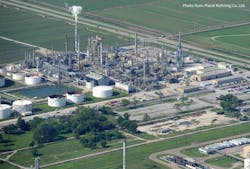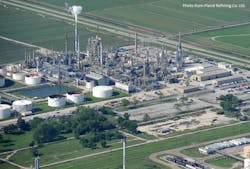Placid Refining Co. LLC has commissioned a grassroots dividing wall column (DWC) reformate splitter as part of a project to comply with US regulatory requirements for benzene content of finished gasoline at its 75,000-b/d refinery in Port Allen, La.
Equipped with KBR Inc.’s proprietary Distill-Max DWC technology, the reformate splitter column is designed to remove benzene from gasoline streams to ensure the finished product complies with limitations under the US Environmental Protection Agency’s Mobile Source Air Toxics Phase II (MSAT II) final rule, KBR said.
Use of Distill-Max DWC technology—which combines two distillation columns within a single shell to enable three or more products to be separated from a feed stream—has resulted in a minimum energy savings of 20% for the Port Allen refinery since startup of the new reformate splitter, according to the service provider.
Alongside technology licensing, KBR said its scope of work on the project included delivery of basic column design, supply of column trays and internals, as well as commissioning support.
First announced in February 2013 and approved in September 2013, the Port Allen project was to involve necessary modifications and additions to existing processing units so that the refinery could effectively comply with MSAT II, which finalized by EPA on Feb. 26, 2007, limits the annual average of benzene content in gasoline to 0.62 vol % by refiner and to 1.3 vol % by refinery, Placid said in filings to the Louisiana Department of Environmental Quality (LDEQ).
The new DWC reformate splitter allows the refinery to produce a benzene-lean MSAT reformate stream and a benzene-rich MSAT benzene stream, the latter of which is loaded off site for sale via barges, according to LDEQ.
HollyFrontier Corp., Dallas, also has completed a MSAT II compliance project involving two DWCs equipped with KBR’s Distill-Max technology at its 135,000 b/sd refinery in El Dorado, Kan., KBR said.
As part of HollyFrontier’s naphtha fractionation project (OGJ Online, Sept. 8, 2015), KBR delivered a grassroots four-product DWC, which is the first DWC of its kind ever to be implemented at a refinery.
Outfitted with Distill-Max Plus, the four-product DWC (vs. a conventional column design) for the naphtha fractionator has resulted in a 25% reduction of the column area as well as a 30% energy savings for the refinery, according to KBR.
The service provider also delivered a revamp of an existing DWC in the overhead section of a crude unit that, alongside improving separation efficiency, has reduced the energy required to remove butanes from straight-run naphtha by 25% vs. use of a conventional three-product column.
Along with technology licensing, KBR’s scope of work on the new and repurposed DWCs at El Dorado included basic column design as well as supply of column trays and internals, the provider said.
Contact Robert Brelsford at [email protected].



